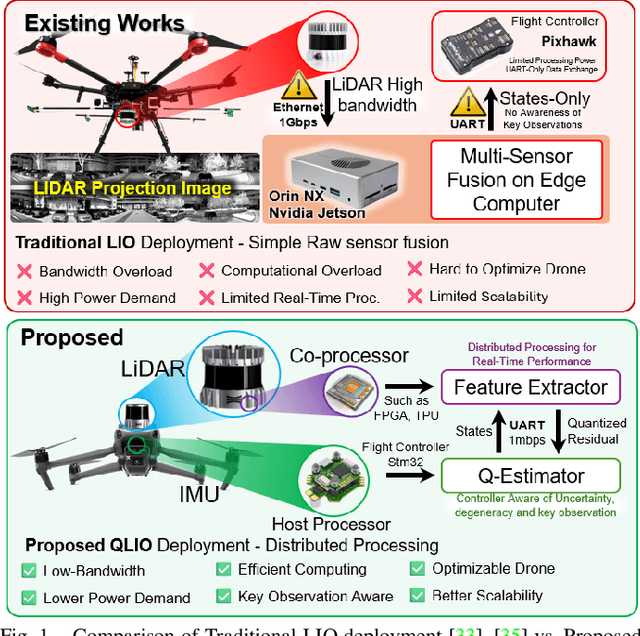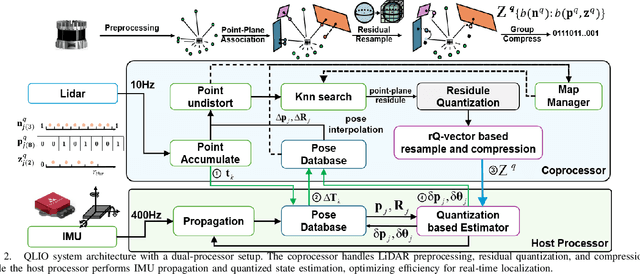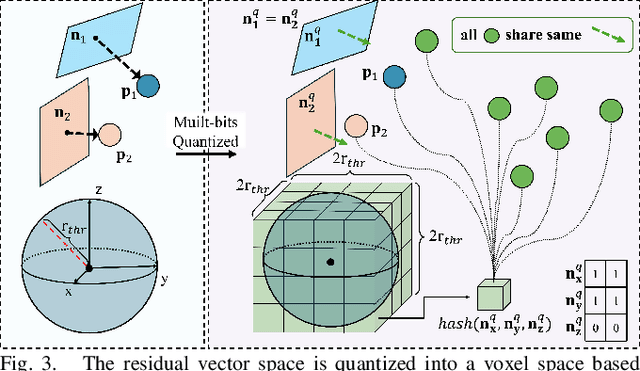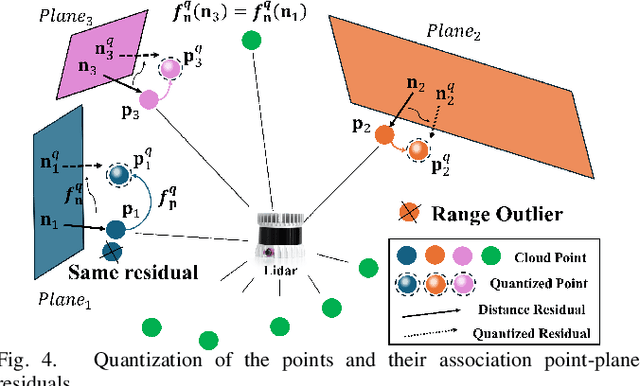Jianfei Yang
HoloLLM: Multisensory Foundation Model for Language-Grounded Human Sensing and Reasoning
May 23, 2025Abstract:Embodied agents operating in smart homes must understand human behavior through diverse sensory inputs and communicate via natural language. While Vision-Language Models (VLMs) have enabled impressive language-grounded perception, their reliance on visual data limits robustness in real-world scenarios with occlusions, poor lighting, or privacy constraints. In this paper, we introduce HoloLLM, a Multimodal Large Language Model (MLLM) that integrates uncommon but powerful sensing modalities, such as LiDAR, infrared, mmWave radar, and WiFi, to enable seamless human perception and reasoning across heterogeneous environments. We address two key challenges: (1) the scarcity of aligned modality-text data for rare sensors, and (2) the heterogeneity of their physical signal representations. To overcome these, we design a Universal Modality-Injection Projector (UMIP) that enhances pre-aligned modality embeddings with fine-grained, text-aligned features from tailored encoders via coarse-to-fine cross-attention without introducing significant alignment overhead. We further introduce a human-VLM collaborative data curation pipeline to generate paired textual annotations for sensing datasets. Extensive experiments on two newly constructed benchmarks show that HoloLLM significantly outperforms existing MLLMs, improving language-grounded human sensing accuracy by up to 30%. This work establishes a new foundation for real-world, language-informed multisensory embodied intelligence.
REI-Bench: Can Embodied Agents Understand Vague Human Instructions in Task Planning?
May 19, 2025Abstract:Robot task planning decomposes human instructions into executable action sequences that enable robots to complete a series of complex tasks. Although recent large language model (LLM)-based task planners achieve amazing performance, they assume that human instructions are clear and straightforward. However, real-world users are not experts, and their instructions to robots often contain significant vagueness. Linguists suggest that such vagueness frequently arises from referring expressions (REs), whose meanings depend heavily on dialogue context and environment. This vagueness is even more prevalent among the elderly and children, who robots should serve more. This paper studies how such vagueness in REs within human instructions affects LLM-based robot task planning and how to overcome this issue. To this end, we propose the first robot task planning benchmark with vague REs (REI-Bench), where we discover that the vagueness of REs can severely degrade robot planning performance, leading to success rate drops of up to 77.9%. We also observe that most failure cases stem from missing objects in planners. To mitigate the REs issue, we propose a simple yet effective approach: task-oriented context cognition, which generates clear instructions for robots, achieving state-of-the-art performance compared to aware prompt and chains of thought. This work contributes to the research community of human-robot interaction (HRI) by making robot task planning more practical, particularly for non-expert users, e.g., the elderly and children.
Generative Dataset Distillation using Min-Max Diffusion Model
Mar 24, 2025Abstract:In this paper, we address the problem of generative dataset distillation that utilizes generative models to synthesize images. The generator may produce any number of images under a preserved evaluation time. In this work, we leverage the popular diffusion model as the generator to compute a surrogate dataset, boosted by a min-max loss to control the dataset's diversity and representativeness during training. However, the diffusion model is time-consuming when generating images, as it requires an iterative generation process. We observe a critical trade-off between the number of image samples and the image quality controlled by the diffusion steps and propose Diffusion Step Reduction to achieve optimal performance. This paper details our comprehensive method and its performance. Our model achieved $2^{nd}$ place in the generative track of \href{https://www.dd-challenge.com/#/}{The First Dataset Distillation Challenge of ECCV2024}, demonstrating its superior performance.
QLIO: Quantized LiDAR-Inertial Odometry
Mar 11, 2025



Abstract:LiDAR-Inertial Odometry (LIO) is widely used for autonomous navigation, but its deployment on Size, Weight, and Power (SWaP)-constrained platforms remains challenging due to the computational cost of processing dense point clouds. Conventional LIO frameworks rely on a single onboard processor, leading to computational bottlenecks and high memory demands, making real-time execution difficult on embedded systems. To address this, we propose QLIO, a multi-processor distributed quantized LIO framework that reduces computational load and bandwidth consumption while maintaining localization accuracy. QLIO introduces a quantized state estimation pipeline, where a co-processor pre-processes LiDAR measurements, compressing point-to-plane residuals before transmitting only essential features to the host processor. Additionally, an rQ-vector-based adaptive resampling strategy intelligently selects and compresses key observations, further reducing computational redundancy. Real-world evaluations demonstrate that QLIO achieves a 14.1% reduction in per-observation residual data while preserving localization accuracy. Furthermore, we release an open-source implementation to facilitate further research and real-world deployment. These results establish QLIO as an efficient and scalable solution for real-time autonomous systems operating under computational and bandwidth constraints.
Emergence of Painting Ability via Recognition-Driven Evolution
Jan 09, 2025Abstract:From Paleolithic cave paintings to Impressionism, human painting has evolved to depict increasingly complex and detailed scenes, conveying more nuanced messages. This paper attempts to emerge this artistic capability by simulating the evolutionary pressures that enhance visual communication efficiency. Specifically, we present a model with a stroke branch and a palette branch that together simulate human-like painting. The palette branch learns a limited colour palette, while the stroke branch parameterises each stroke using B\'ezier curves to render an image, subsequently evaluated by a high-level recognition module. We quantify the efficiency of visual communication by measuring the recognition accuracy achieved with machine vision. The model then optimises the control points and colour choices for each stroke to maximise recognition accuracy with minimal strokes and colours. Experimental results show that our model achieves superior performance in high-level recognition tasks, delivering artistic expression and aesthetic appeal, especially in abstract sketches. Additionally, our approach shows promise as an efficient bit-level image compression technique, outperforming traditional methods.
Unsupervised UAV 3D Trajectories Estimation with Sparse Point Clouds
Dec 17, 2024Abstract:Compact UAV systems, while advancing delivery and surveillance, pose significant security challenges due to their small size, which hinders detection by traditional methods. This paper presents a cost-effective, unsupervised UAV detection method using spatial-temporal sequence processing to fuse multiple LiDAR scans for accurate UAV tracking in real-world scenarios. Our approach segments point clouds into foreground and background, analyzes spatial-temporal data, and employs a scoring mechanism to enhance detection accuracy. Tested on a public dataset, our solution placed 4th in the CVPR 2024 UG2+ Challenge, demonstrating its practical effectiveness. We plan to open-source all designs, code, and sample data for the research community github.com/lianghanfang/UnLiDAR-UAV-Est.
Audio Array-Based 3D UAV Trajectory Estimation with LiDAR Pseudo-Labeling
Dec 17, 2024Abstract:As small unmanned aerial vehicles (UAVs) become increasingly prevalent, there is growing concern regarding their impact on public safety and privacy, highlighting the need for advanced tracking and trajectory estimation solutions. In response, this paper introduces a novel framework that utilizes audio array for 3D UAV trajectory estimation. Our approach incorporates a self-supervised learning model, starting with the conversion of audio data into mel-spectrograms, which are analyzed through an encoder to extract crucial temporal and spectral information. Simultaneously, UAV trajectories are estimated using LiDAR point clouds via unsupervised methods. These LiDAR-based estimations act as pseudo labels, enabling the training of an Audio Perception Network without requiring labeled data. In this architecture, the LiDAR-based system operates as the Teacher Network, guiding the Audio Perception Network, which serves as the Student Network. Once trained, the model can independently predict 3D trajectories using only audio signals, with no need for LiDAR data or external ground truth during deployment. To further enhance precision, we apply Gaussian Process modeling for improved spatiotemporal tracking. Our method delivers top-tier performance on the MMAUD dataset, establishing a new benchmark in trajectory estimation using self-supervised learning techniques without reliance on ground truth annotations.
NoisyEQA: Benchmarking Embodied Question Answering Against Noisy Queries
Dec 14, 2024



Abstract:The rapid advancement of Vision-Language Models (VLMs) has significantly advanced the development of Embodied Question Answering (EQA), enhancing agents' abilities in language understanding and reasoning within complex and realistic scenarios. However, EQA in real-world scenarios remains challenging, as human-posed questions often contain noise that can interfere with an agent's exploration and response, bringing challenges especially for language beginners and non-expert users. To address this, we introduce a NoisyEQA benchmark designed to evaluate an agent's ability to recognize and correct noisy questions. This benchmark introduces four common types of noise found in real-world applications: Latent Hallucination Noise, Memory Noise, Perception Noise, and Semantic Noise generated through an automated dataset creation framework. Additionally, we also propose a 'Self-Correction' prompting mechanism and a new evaluation metric to enhance and measure both noise detection capability and answer quality. Our comprehensive evaluation reveals that current EQA agents often struggle to detect noise in questions, leading to responses that frequently contain erroneous information. Through our Self-Correct Prompting mechanism, we can effectively improve the accuracy of agent answers.
Look a Group at Once: Multi-Slide Modeling for Survival Prediction
Nov 18, 2024



Abstract:Survival prediction is a critical task in pathology. In clinical practice, pathologists often examine multiple cases, leveraging a broader spectrum of cancer phenotypes to enhance pathological assessment. Despite significant advancements in deep learning, current solutions typically model each slide as a sample, struggling to effectively capture comparable and slide-agnostic pathological features. In this paper, we introduce GroupMIL, a novel framework inspired by the clinical practice of collective analysis, which models multiple slides as a single sample and organizes groups of patches and slides sequentially to capture cross-slide prognostic features. We also present GPAMamba, a model designed to facilitate intra- and inter-slide feature interactions, effectively capturing local micro-environmental characteristics within slide-level graphs while uncovering essential prognostic patterns across an extended patch sequence within the group framework. Furthermore, we develop a dual-head predictor that delivers comprehensive survival risk and probability assessments for each patient. Extensive empirical evaluations demonstrate that our model significantly outperforms state-of-the-art approaches across five datasets from The Cancer Genome Atlas.
AV-PedAware: Self-Supervised Audio-Visual Fusion for Dynamic Pedestrian Awareness
Nov 11, 2024



Abstract:In this study, we introduce AV-PedAware, a self-supervised audio-visual fusion system designed to improve dynamic pedestrian awareness for robotics applications. Pedestrian awareness is a critical requirement in many robotics applications. However, traditional approaches that rely on cameras and LIDARs to cover multiple views can be expensive and susceptible to issues such as changes in illumination, occlusion, and weather conditions. Our proposed solution replicates human perception for 3D pedestrian detection using low-cost audio and visual fusion. This study represents the first attempt to employ audio-visual fusion to monitor footstep sounds for the purpose of predicting the movements of pedestrians in the vicinity. The system is trained through self-supervised learning based on LIDAR-generated labels, making it a cost-effective alternative to LIDAR-based pedestrian awareness. AV-PedAware achieves comparable results to LIDAR-based systems at a fraction of the cost. By utilizing an attention mechanism, it can handle dynamic lighting and occlusions, overcoming the limitations of traditional LIDAR and camera-based systems. To evaluate our approach's effectiveness, we collected a new multimodal pedestrian detection dataset and conducted experiments that demonstrate the system's ability to provide reliable 3D detection results using only audio and visual data, even in extreme visual conditions. We will make our collected dataset and source code available online for the community to encourage further development in the field of robotics perception systems.
 Add to Chrome
Add to Chrome Add to Firefox
Add to Firefox Add to Edge
Add to Edge